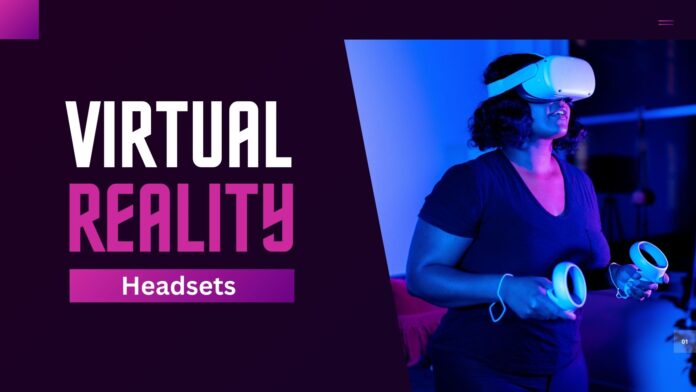Exploring the Realms of Virtual Reality Headsets
Virtual reality (VR) headsets have become the gateway to fantastical worlds, revolutionizing entertainment, education, and even professional applications. These head-mounted displays transport users into immersive environments, blurring the lines between the digital and the real. But how exactly do VR headsets work, and what potential do they hold for the future?
Unpacking the Tech: How VR Headsets Create Artificial Worlds
VR headsets achieve their magic through a combination of hardware and software. Let’s delve into the key components:
- Display: The heart of the VR experience, the display presents a stereoscopic image, one for each eye. This creates the illusion of depth and three-dimensional space. Modern VR headsets utilize high-resolution displays with fast refresh rates to minimize motion blur and ensure a smooth visual experience.
- Sensors: VR headsets are equipped with various sensors, including accelerometers, gyroscopes, and magnetometers. These sensors track the user’s head movement, rotation, and position in real-time. This allows the virtual environment to dynamically adjust based on the user’s head orientation, creating a sense of presence within the virtual world.
- Processing Unit: For standalone VR headsets, a powerful processing unit is crucial. It renders the virtual environment, processes user input from controllers, and ensures smooth performance. In PC-connected VR headsets, the processing power comes from the user’s computer.
- Software: The software running on the VR headset or connected computer generates the virtual environment. This software can be a game engine for VR games, a platform for 360° videos, or specialized applications designed for specific purposes like education or training.
Beyond Gaming: Unveiling the Diverse Applications of VR Headsets
While VR gaming remains a major driving force for headset development, the technology’s potential extends far beyond entertainment. Here’s a glimpse into some exciting applications:
- Education and Training: VR headsets can transform classrooms into immersive learning environments. Imagine exploring the depths of the ocean, dissecting a virtual frog, or taking a virtual tour of historical landmarks. VR simulations can also be used for professional training, allowing pilots to practice emergency situations or surgeons to rehearse complex procedures.
- Design and Architecture: VR headsets enable architects and designers to visualize their creations in a three-dimensional space before construction begins. This allows for better collaboration, identification of potential issues early on, and a more immersive design experience.
- Healthcare and Therapy: VR is making waves in the healthcare field. Therapists can use VR to treat phobias, manage pain, and help patients with post-traumatic stress disorder (PTSD). VR can also be used for physical therapy, allowing patients to practice movements in a safe and controlled environment.
- Virtual Travel and Tourism: Imagine exploring the Great Barrier Reef or scaling the peaks of Mount Everest without leaving your living room. VR headsets can provide realistic travel experiences, allowing users to explore exotic locations and cultures virtually.
The Future of VR Headsets: A Glimpse into the Evolving Landscape
The VR landscape is constantly evolving, with advancements happening at a rapid pace. Here are some exciting trends to watch out for:
- Wireless Freedom: Tethered VR headsets, reliant on a connection to a powerful computer, are gradually giving way to standalone headsets. These self-contained units offer greater mobility and convenience, making VR more accessible.
- Haptic Feedback and Sensory Enhancements: The next generation of VR headsets might incorporate haptic feedback technology, allowing users to not only see and hear the virtual world, but also feel it. Imagine the sensation of climbing a virtual rock wall or the impact of a virtual object.
- Eye-Tracking Technology: Eye-tracking sensors within VR headsets can revolutionize the user experience. Imagine focusing your gaze on an object to interact with it, or having the virtual environment adjust its details based on where you’re looking.
- Brain-Computer Interfaces (BCIs): The ultimate frontier of VR might involve BCIs, which could directly translate brain activity into actions within the virtual world. Imagine controlling your virtual avatar with your thoughts or experiencing emotions within the VR environment that mirror your own.
The Ethical Considerations of VR Headsets
As VR technology advances, it’s crucial to consider the ethical implications. Here are some key points to ponder:
- Addiction and Immersion: The immersive nature of VR raises concerns about potential addiction. It’s important to maintain a healthy balance between the virtual world and the real one.
- Privacy Issues: VR experiences often collect user data, including head movements and even eye movements in the future. It’s important for users to be aware of how this data is collected and used.
- Accessibility and Inclusivity: VR experiences should be designed to be accessible to a wide range of users, including those with disabilities.
VR headsets are powerful tools, but their true potential is unlocked by compelling content. Let’s explore the current state of VR content creation and future possibilities:
The Content Creation Challenge: Building Worlds for the Metaverse
Developing high-quality VR content presents unique challenges. Creating realistic 3D environments, designing intuitive interactions, and crafting engaging narratives all require specialized skills and tools. Additionally, VR content needs to be optimized for specific hardware functionalities and user comfort.
Virtual Reality Headsets is the Future
Here are some of the key considerations for VR content creation:
- Interactive Storytelling: VR offers new avenues for interactive storytelling. Imagine branching narratives where user choices shape the story’s direction, or VR experiences that blur the lines between user and character.
- 360° Video and Filmmaking: Capturing immersive 360° video footage opens doors for virtual travel experiences, documentaries, and even fictional narratives.
- Social VR Experiences: The rise of the metaverse, a persistent virtual world, highlights the potential for social VR experiences. Imagine attending virtual concerts, collaborating in virtual workspaces, or simply hanging out with friends in a virtual world.
Who’s Building the VR World? A Look at Industry Players
The VR landscape is brimming with innovative companies and individuals pushing the boundaries of content creation. Here are some key players:
- Gaming Studios: Major gaming studios are actively developing VR games, offering immersive experiences across various genres.
- Independent Developers: Independent developers are also contributing significantly to the VR content landscape, creating innovative and experimental experiences.
- Filmmakers and Videographers: Forward-thinking filmmakers and videographers are exploring the potential of VR for storytelling and documentary filmmaking.
- Educational Institutions: Universities and research institutions are developing VR experiences for educational purposes, creating immersive learning environments.
User-Generated Content: Democratizing the Virtual Reality Experience
The future of VR content might not solely rely on established studios and developers. User-generated content (UGC) platforms could empower users to create and share their own VR experiences. Imagine a scenario where users can build virtual worlds, design interactive games, or even develop educational simulations, fostering a more diverse and dynamic VR ecosystem.
More Info: HVAC Companies Digital Marketing Strategies
Safety and Wellbeing in VR: Essential Considerations for Users
While VR offers incredible experiences, it’s crucial to prioritize user safety and well-being. Here are some key points to remember:
- Motion Sickness and Discomfort: VR experiences can trigger motion sickness in some users. It’s important to take breaks and adjust settings to minimize discomfort.
- Eye Strain and Visual Fatigue: Extended VR use can cause eye strain and fatigue. Following the 20-20-20 rule (looking at something 20 feet away for 20 seconds every 20 minutes) can help alleviate these issues.
- Physical Safety and Spatial Awareness: VR can make users oblivious to their physical surroundings. It’s important to use VR in a clear and safe space free from obstacles.
Conclusion: Embracing the Future of Virtual Reality Headsets
VR headsets are no longer a futuristic fantasy; they are a rapidly evolving technology with the potential to transform entertainment, education, and even professional applications. As hardware advancements continue, content creation flourishes, and ethical considerations are addressed, Virtual Reality Headsets has the power to reshape the way we interact with the digital world. Whether you’re a gamer, an educator, or simply someone curious about the future, VR headsets offer a gateway to a world of possibilities, waiting to be explored.






